Part A: OLED simulation - Quick start
1. Overview of simulating OLEDs
Organic Light Emitting Diodes (OLEDs) are at the heart of modern display and lighting technologies. They work by injecting charge carriers from the electrodes into organic layers, where recombination produces light through electroluminescence. In OghmaNano, OLED simulations combine the drift–diffusion models described elsewhere in this manual with optical models to simulate how light propagates out of the device.
In this tutorial, we will explore two ready-made OLED examples in OghmaNano. Understanding OLEDs requires both electrical and optical analysis. To illustrate this, one example focuses on the transfer matrix method (TMM), which is particularly well suited for smooth, layered structures such as evaporated OLEDs. This method enables detailed study of optical outcoupling and the calculation of L–I–V curves, voltage–EQE dependence, and EQE spectra. The second example employs a ray-tracing approach, which is more appropriate for devices with rough surfaces or embedded micro-lenses, allowing you to examine how light is emitted to the outside world as a function of angle.
Together, these techniques provide powerful tools for OLED design and optimisation—especially for display applications where viewing-angle dependence of colour plays a critical role.
2. Optical emission
A critical aspect of OLED design is understanding how much of the internally generated light actually escapes the device. Most photons are lost to waveguided or plasmonic modes, and only a fraction reach the outside world. This is where the transfer matrix method (TMM) becomes invaluable: it allows us to predict how interference within the thin-film stack redistributes emission, and how changes in layer thickness or refractive index alter the fraction of light that is outcoupled. By running a TMM simulation first, we gain essential insight into the optical efficiency of the device and the role of the layered microcavity — making it the logical starting point for OLED design.
To explore this, open the OLED (TMM) example simulation by double-clicking it in the New simulation window. This loads the main interface shown in ??, where the 3D device stack and editor panels are displayed.

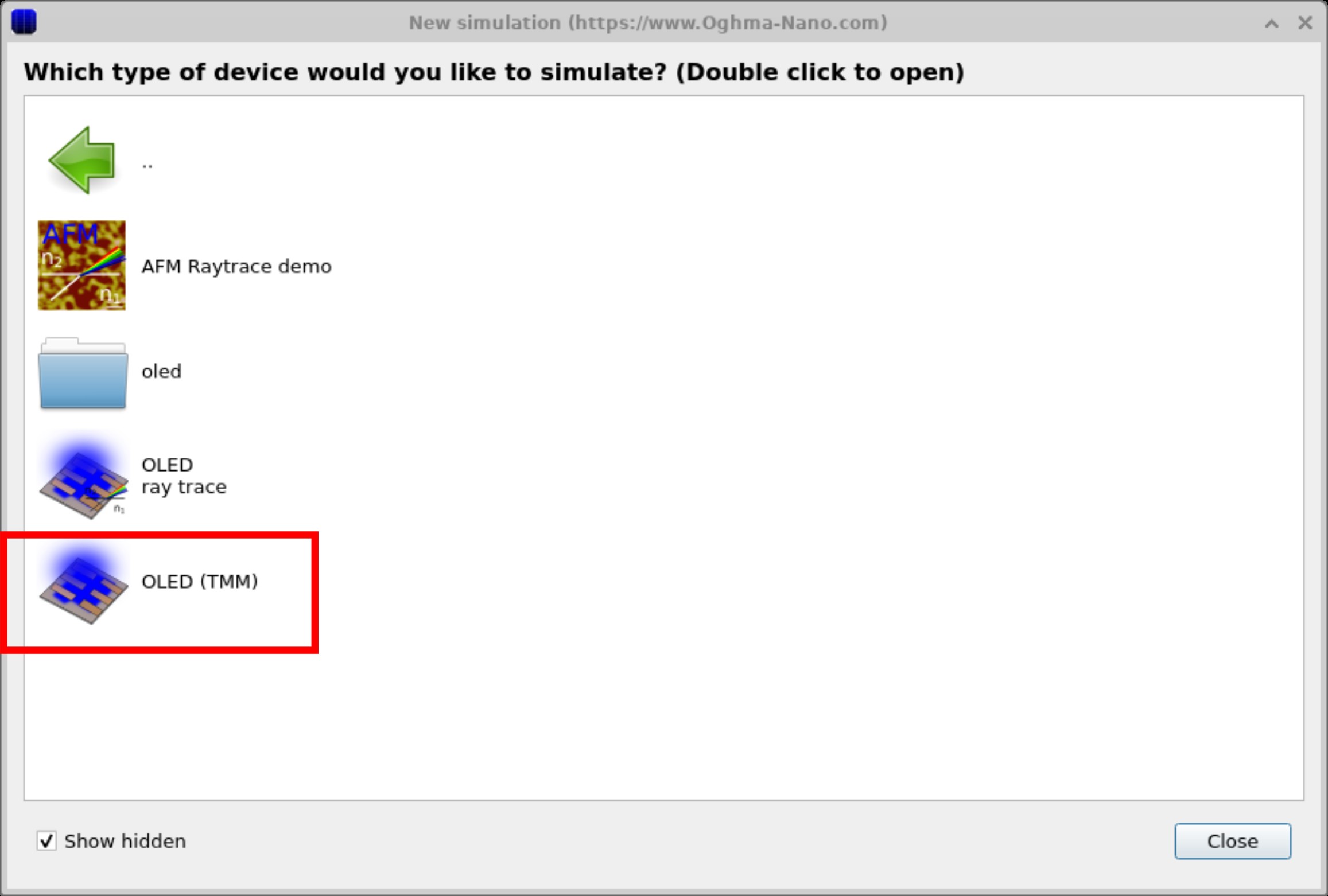
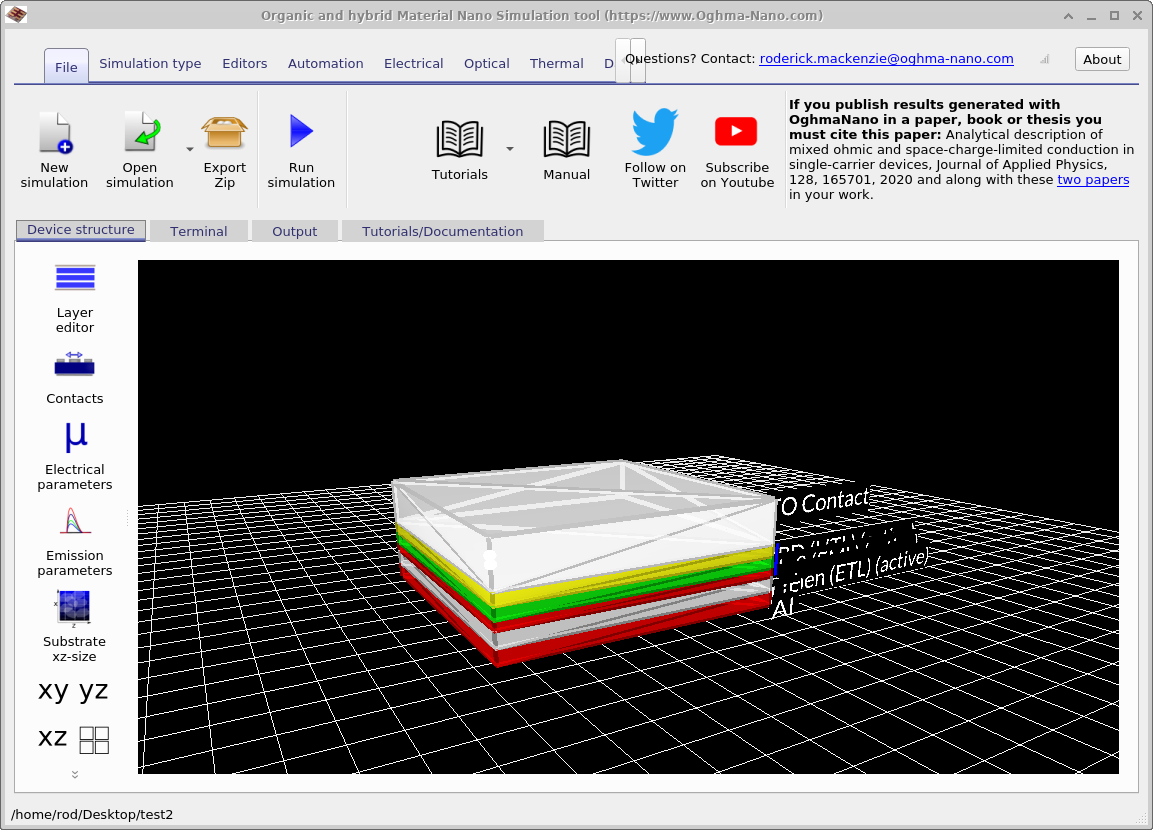
To access the optical tools, switch to the Optical ribbon (??) and click on the Optical outcoupling button. This opens the Optical outcoupling tool, shown in ??.

To begin the calculation, click the Play button. The simulation will calculate the spatial and spectral distribution of emitted photons, and the final windows should look like ?? which plots the Escape probability as a function of wavelength and position within the device. This figure shows the escape probability as a function of wavelength (vertical axis) and depth within the OLED stack (horizontal axis). Bright red regions indicate combinations of wavelength and position where photons have a high chance of escaping to the outside, while the dark blue background corresponds to trapped light. The alternating bands reflect interference between forward- and backward-propagating waves, revealing how the microcavity redistributes emission. Such maps provide direct guidance on which layer thicknesses and emission wavelengths favour efficient outcoupling.
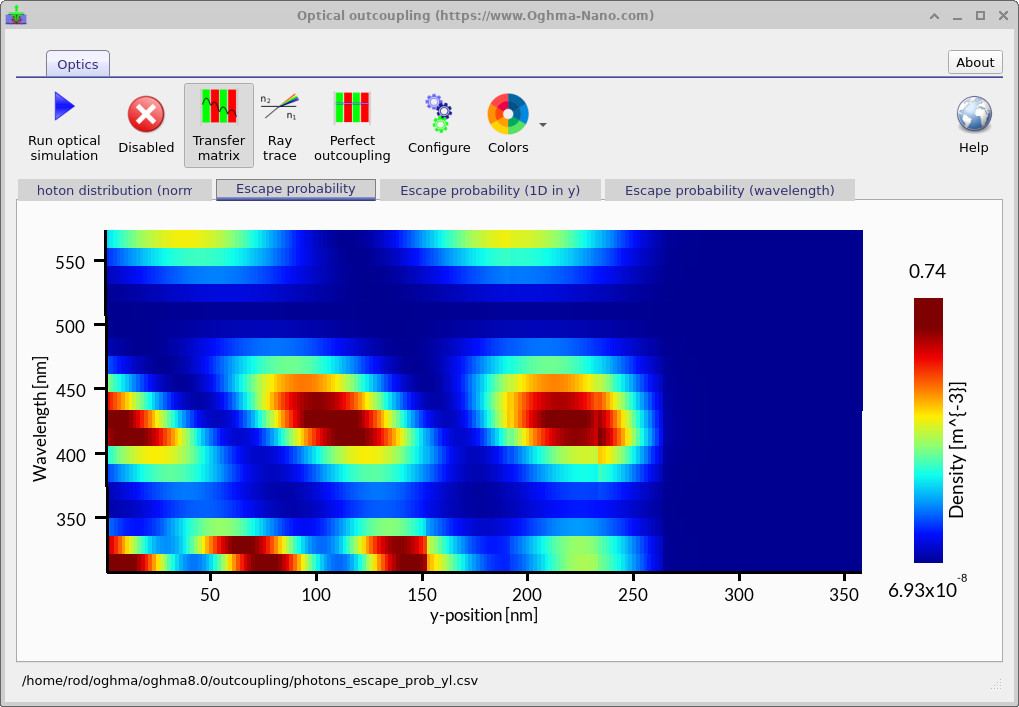
Electrical simulations combined with optical transfer matrix calculations
Now that you have explored optical outcoupling with the Transfer Matrix Method (TMM), you can combine this with drift–diffusion modeling to understand how an OLED emits light as a function of current and voltage. In these combined simulations, the recombination profile from the drift–diffusion calculation provides the emissive source, which is then coupled into the optical outcoupling model. The simulation first performs an optical outcoupling calculation, just as described above, and then runs a standard electrical drift–diffusion simulation to generate the current–voltage (JV) response. The user should return to the main interface and press the Run simulation button (▶) to launch the full calculation. The results of the combined electro–optical simulation are written to the Output tab and appear as shown in ??.
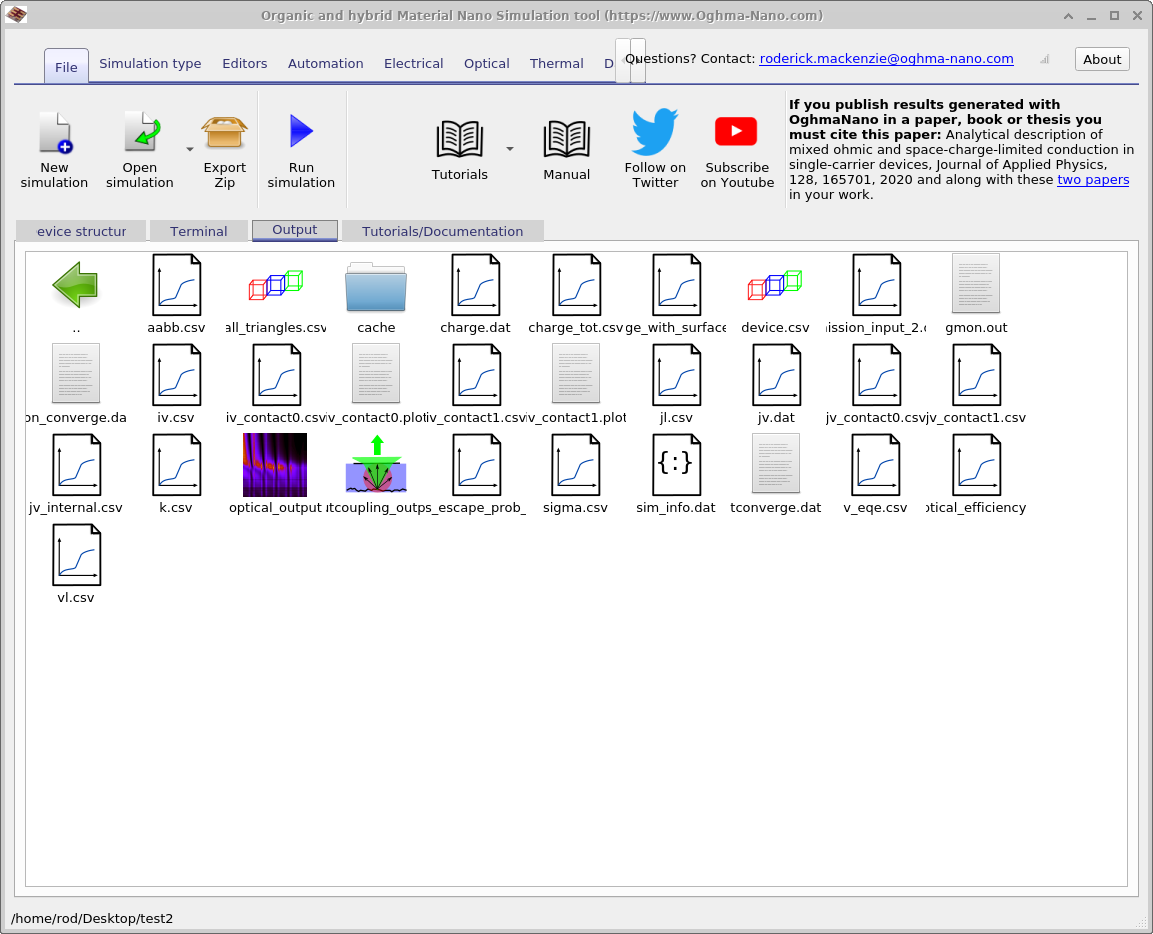
The simulation writes a number of output files to the Output tab. These files contain the key numerical results of the combined optical and electrical OLED simulation and can be used for further analysis or plotting. The most important files are described below in Table 7.1.
| File name | Description |
|---|---|
iv.csv |
Current vs. voltage |
jv.csv |
Current density vs. voltage |
jl.csv |
Current density vs. optical output power density |
k.csv |
Averaged recombination rate constant vs. voltage |
v_eqe.csv |
Voltage vs. EQE |
vl.csv |
Voltage vs. optical output power density |
Snapshots/ |
Snapshots of the electrical device parameters for each simulation step |
The key output characteristics of the combined electrical–optical OLED simulation are shown in
?? and
??.
The current density–light flux curve (jl.csv) demonstrates how the emitted optical power rises with
increasing drive current, showing the typical nonlinear increase once carrier recombination becomes efficient.
The voltage–EQE curve (v_eqe.csv) reveals how the external quantum efficiency sharply increases above
the turn-on voltage, reflecting the transition from low-level leakage currents to radiative recombination dominating
the device output.
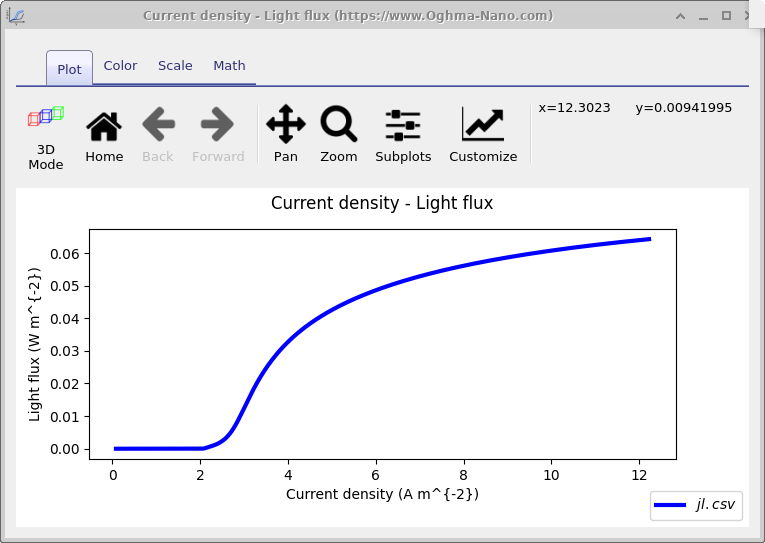
jl.csv) curve from the OLED simulation.
This shows how the emitted optical power scales with electrical drive current.

v_eqe.csv) curve from the OLED simulation.
The EQE rises steeply once the turn-on voltage is reached, reflecting the onset of radiative recombination.
The snapshots directory in the output folder contains detailed electrical output from the model for each simulation step
(see ??).
Among these files is eqe.csv, which stores the calculated external quantum efficiency (EQE) spectrum
as a function of applied voltage.
The EQE spectrum evolves with voltage because the recombination profile within the device changes:
different regions of the cavity contribute to emission, and each region couples out specific wavelengths with
different efficiencies.
As a result, the overall spectrum observed externally shifts as the bias is varied.
Use the slider control in the results viewer to explore how the EQE spectrum changes with voltage.
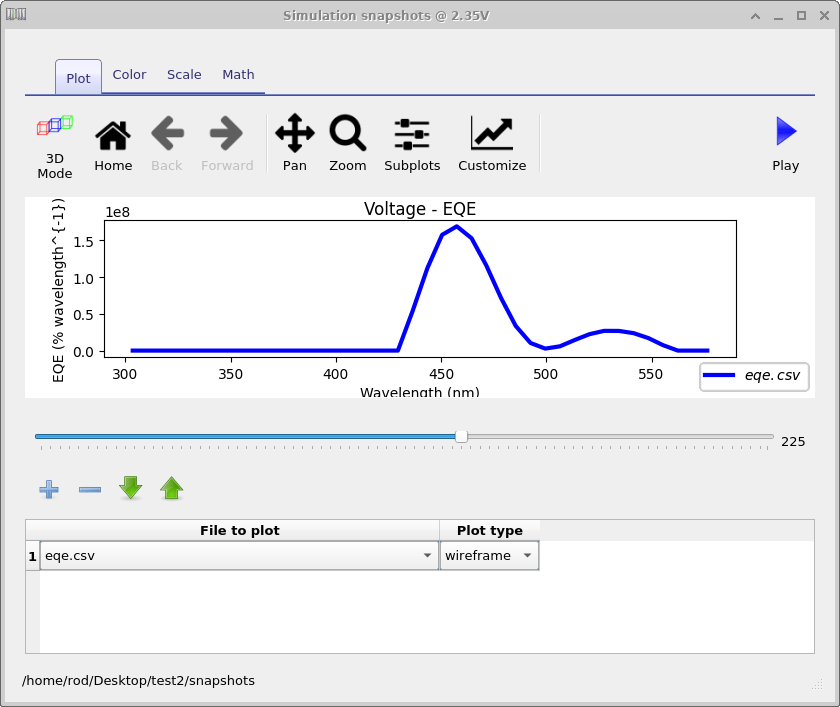
👉 Next step: Continue to Part B to learn about ray tracing and angle-dependent emission.